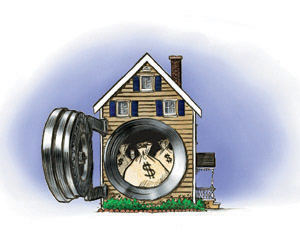How Builders Can Be Better at Business
10 strategies to help properly manage time and money to make the business end of building easier.

One of the most satisfying jobs in the world is being a builder. And one of the most potentially frustrating jobs in the world is being a builder. The problem lies in squaring the joys of building something beautiful and useful with the quagmire of financing, bookkeeping and all the business-oriented tasks that come wrapped in red tape. I know, you’re in the game for the joy of building, not necessarily for money. But as mom used to say, “Richer or poorer, having money is better!”
After nearly eight years of national prosperity in the construction industry, there continues to be one prominent shortage: time. The only way to gain on the situation is to use time better. To that end, I offer the following suggestions. Think of this list as a web of strategies-one is not more important than any other. However, if you are going to be successful with No. 10, you’ll need to demonstrate competence in Nos. 1-9.
1. Get Organized
My old boss, Dwayne, used his truck as a file cabinet. The dashboard was the in box. The console was for important papers, and the floor was storage for the IRS’s three-year receipt requirement. To find the oldest receipts, Dwayne simply rustled to the bottom of the stack.
Instead, you should touch paper once. An investment of $25 in clipboards and files could have simplified Dwayne’s life. The downside of organization, of course, is that he would know which bills were due.
2. Use professional marketing help
The builder down the street has his building permit stapled to a piece of scrap plywood that’s nailed to a stick and then planted in a nasty 5-gal. bucket sitting out by the curb. Now there’s some marketing that says, “For a builder who doesn’t sweat the details, see me!”
A onetime expenditure of $400 should provide you with business cards, stationery and a logo. Once you’ve got it, use it. Always carry a huge supply of business cards, and hand them out like candy. Use letterhead for bids and correspondence. Adorn your vehicles with signage. Place your yard sign at conspicuous jobs. That sign will work hard for you during the evenings and weekends when customers are out looking.
And if you’re thinking, “The last thing I need is more business,” think again. Marketing can create a brand for your business that stands for quality and competence, traits that are synonymous with higher prices. The goal isn’t just more business, it’s better business. You don’t want every job, just the best jobs.
3. Schedule jobs reliably
A major supplier conducted a focus group with eight general contractors to discover what wins the bid for a given project. The results may surprise you:
• Reliable schedule management.
• Quality fit and finish.
• Competent workmen.
• Competitive price.
The consensus was that most bids come in close in dollar terms, so the deciding factors become reliability, quality and competency. Bottom line:?Interest expense is one of the single largest cost categories on any project. Borrowing $100,000 at 10% interest costs about $27.50 per day. Whoever cuts the checks knows interest expense all too well. It’s worth paying a little extra for the contractor who gets the job done on time.
4. Keep it clean

There aren’t enough moms in the construction trades. Think about the most successful builders working in your area. Are they messy? The principle of uniformity suggests that the unseen is generally consistent with the seen. A visibly organized job site suggests professional diligence in all aspects of life. It goes back to the concept of creating a brand for your business. Cleanliness on the job site builds a quality reputation among tradesmen, bankers and consumers alike.
5. Be a mentor
Chronic shortages exist on both sides of the labor equation. There are scores of young people waiting for a break. And you could use some help during the construction season. Make the commitment to hire and mentor an apprentice. You may find yourself making a large difference in someone’s life while creating a little more time for yourself.
6. Computerize

Incredibly, there are builders who haven’t joined the computer age. The newest low-end accounting software feature simple setup, easy-to-use Web-site templates, $25-per-month Web hosting, even acceptance of credit-card payments. Accounting spreadsheets, such as Excel, have marvelous functions. If you don’t use spreadsheets yet, jump in, the water is fine. Repeat after me: “Accounting is fun, and computers are my friend.” For marketing work on-line, it’s amazing what you can do with a digital camera and the new Web-page software.
7. Strengthen supplier relations
We are all familiar with terms 2/10, net 30 (2% discount if the monthly bill is paid in 10 days, or pay the full amount in 30 days). According to the accounting textbook, taking this discount is the same as earning 37% annually on your money. That’s a lot less expensive than borrowed money.
8. Strengthen banking relations

Do you have an updated financial statement? How about giving your banker those updated financials, for no other reason than good form. Use bank templates to detail your balance sheet (assets = liabilities + owner’s equity) and income statement (revenues – expenses = profit). Planning to borrow? Your banker should have the last three years’ tax returns on file. “Rest” lines of credit; your banker wants to see a zero balance on lines of credit at least once per year.
9. Innovate
Many builders are stiff as prom hair in their approach. Hey, if it ain’t broke, why fix it? The result is bland. Innovation is an excellent way to create reputation and value. For example, consider using some recycled materials, or promote otherwise wasted space into clever storage areas. Have your apprentice build your innovations. Consumers will demonstrate appreciation with a sale, and your reputation as a leading builder will be enhanced.
10. Invest

You’re making a good living, but are you making any money? Wealth is measured on the balance sheet, not the income statement. Consider boosting your retirement fund with an annual purchase of at least one rental property. Put the pencil to funding 25 years of retirement, and the need becomes evident.
Finally, keep in mind that a goal without a deadline isn’t a goal. Set goals and deadlines, make lists every day, and hustle. As Abraham Lincoln said, “Things may come to those that wait, but only the things left by those that hustle.
Illustrations by Matt Collins

























